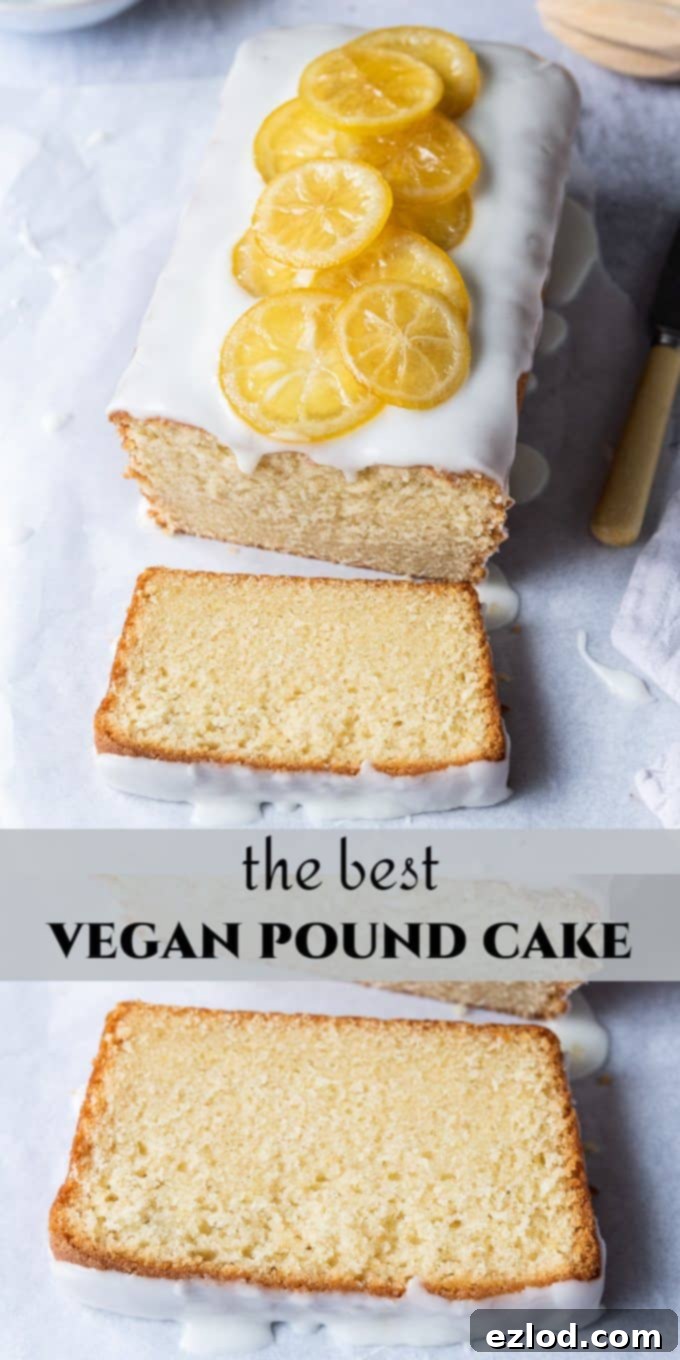Ultimate Vegan Lemon Pound Cake: Moist, Zesty & Perfectly Plant-Based
Experience the delightful taste of this vegan lemon pound cake – a truly exceptional lemon loaf cake that is incredibly soft, wonderfully moist, and bursting with zesty lemon flavor. It delivers the classic dense, melt-in-the-mouth texture synonymous with a perfect pound cake, all while being entirely plant-based. Plus, with a simple tweak, you can effortlessly transform this recipe into an equally delicious vegan vanilla pound cake if you prefer a different classic!

This vegan lemon pound cake stands out as one of my most cherished and successful cake recipe creations to date. From the very first bite, you’ll appreciate its perfectly moist and wonderfully soft interior, achieving that ideal density without ever feeling heavy or claggy. It boasts an incredibly tender crumb and a delicate, yet distinct, lemon flavor that brightens the palate.
What makes this plant-based lemon pound cake truly special is its versatility. It’s one of those effortlessly elegant cakes that tastes divine simply on its own, making it a perfect everyday snack with a cup of tea or coffee. Elevate it for a more sophisticated dessert by serving it warm with a vibrant fruit compote, a dollop of creamy vegan whipped cream, or a scoop of your favorite dairy-free ice cream. Its comforting yet refined character makes it suitable for both casual gatherings and special occasions.
The inspiration for this recipe came from adapting my longstanding and much-loved non-vegan pound cake. I am absolutely thrilled to confirm that this vegan version is every bit as delicious and satisfying as I remember the original being, proving that you don’t need dairy or eggs to achieve an exceptional pound cake.
What Exactly Is Pound Cake? Understanding This Classic Delight
Pound cake is a time-honored classic in the world of baking, renowned for its distinctly dense, rich, and moist texture with a beautifully tight, soft crumb. It offers a wonderfully different experience compared to the lighter, airier sponge cakes. Typically, this hearty cake is baked in either a traditional loaf tin or an ornate Bundt tin, resulting in its characteristic shape.
The name “pound cake” originated in the 1700s, reflecting its original recipe formula: a pound each of flour, sugar, butter, and eggs. This straightforward, robust ingredient list was easy to remember and resulted in a substantial cake. Over centuries, pound cake recipes have naturally evolved. Bakers have refined the proportions and added leavening agents to make the cake a little lighter, less prone to dryness, and more flavourful. Today, many countries and cultures boast their own unique variations of this beloved classic.
For this modern vegan adaptation of pound cake, the most significant departure from tradition is the innovative swap of eggs for silken tofu. While adding tofu to a cake might initially sound unusual, trust me when I say it is a game-changer for achieving that desired pound cake texture in a plant-based form! I wouldn’t typically use silken tofu as a universal egg replacement in all cake recipes, as its properties are quite specific. However, in this particular recipe, where our goal is to achieve that soft, incredibly dense, and truly melt-in-your-mouth texture that defines a perfect pound cake, silken tofu performs its role flawlessly. It binds the ingredients, provides moisture, and contributes to the rich mouthfeel, all without imparting any noticeable flavour. You genuinely won’t taste the tofu at all – only pure, luscious lemon goodness.
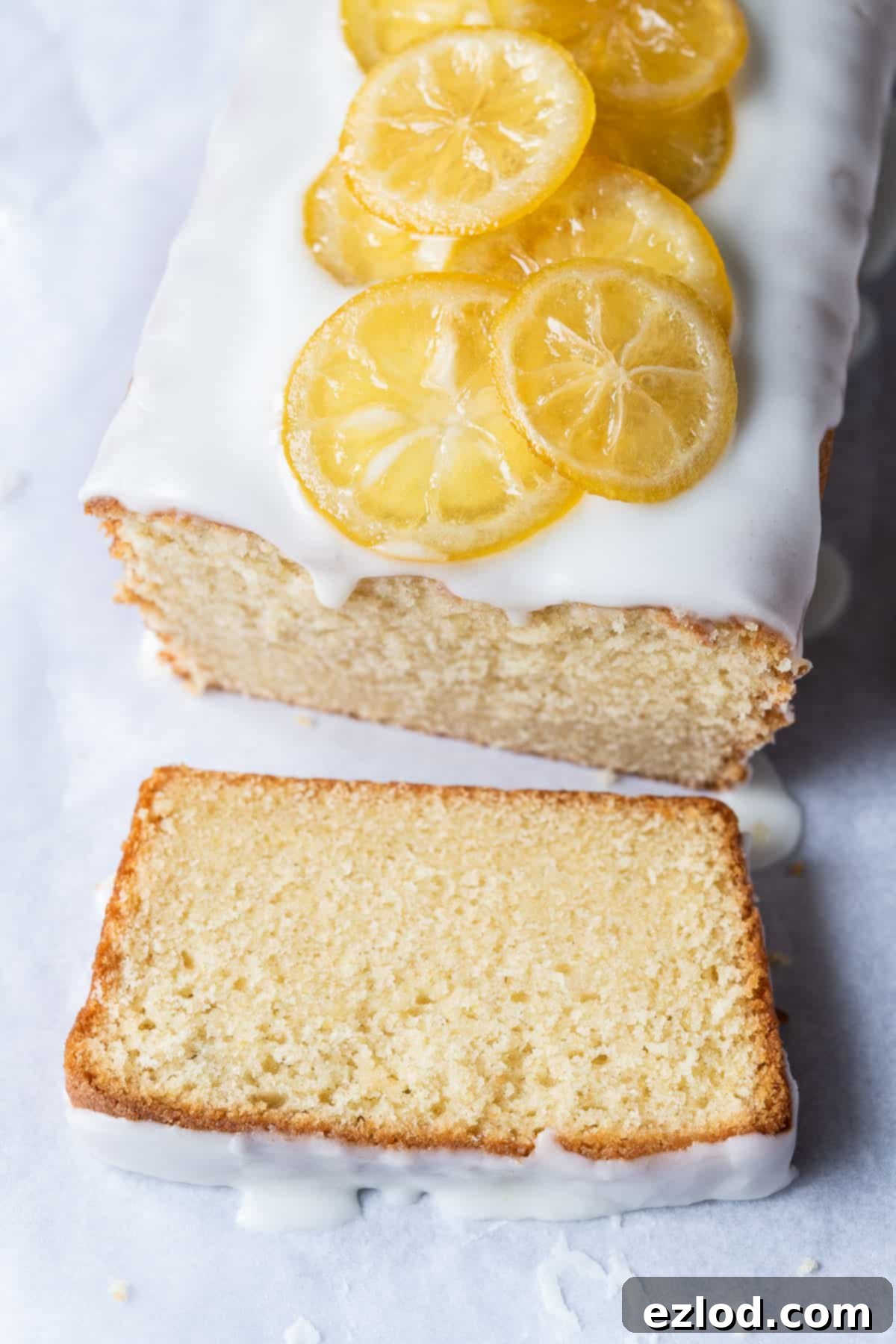
Crafting Your Delicious Vegan Lemon Pound Cake: A Step-by-Step Guide
(For a detailed list of ingredients and precise instructions, please refer to the comprehensive recipe card located further below.)
Begin your baking journey by preparing your dry ingredients. Sift together the self-raising flour, bicarbonate of soda, and a pinch of salt. Sifting is a crucial step as it aerates the flour, prevents lumps, and ensures an even distribution of the leavening agents, all contributing to a lighter, more uniform crumb in your finished cake. Once sifted, set this mixture aside.
Next, prepare your wet ingredients. In a blender, combine the silken tofu, non-dairy milk (soy milk is often recommended for its creamy texture and neutral flavour, but oat or almond milk can also work), fresh lemon juice, a generous amount of finely grated lemon zest (which provides the majority of the vibrant lemon flavour), sunflower oil (or any other neutral-tasting oil), and a touch of vanilla extract. Blend these ingredients until the mixture is completely smooth and creamy, ensuring no lumps of tofu remain. This creates a wonderfully emulsified base for your cake. Set this liquid mixture aside as well.
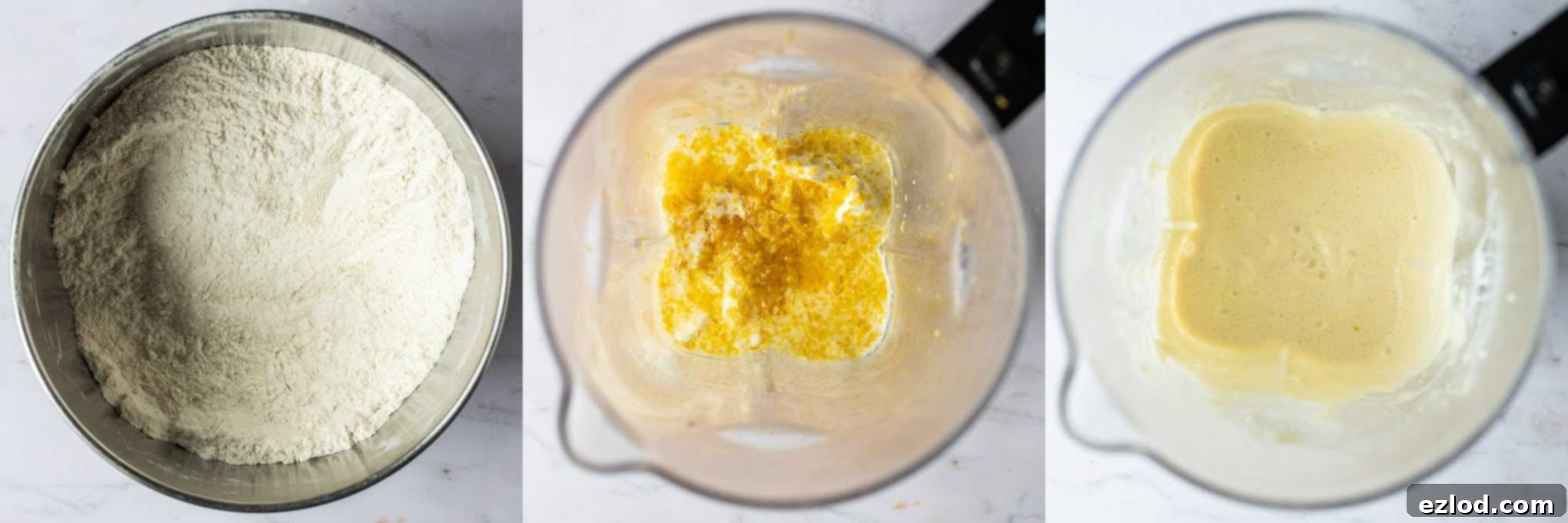
Now, in a large mixing bowl, using an electric mixer, cream together the softened vegan block butter and caster sugar. Beat them until they are thoroughly combined and lightened in colour and texture. This creaming process incorporates air into the butter, which is essential for the cake’s structure and tenderness.
Gradually, add about half of your prepared wet ingredients to the creamed butter and sugar mixture. Whisk this until it is smooth and well incorporated. Don’t be alarmed if the mixture appears slightly split or curdled at this stage; this is perfectly normal and will resolve as more ingredients are added.
Next, add approximately half of the dry ingredients to the bowl and whisk gently until just combined. Immediately follow this by whisking in the remaining wet ingredients, ensuring a smooth blend. Finally, incorporate the rest of the dry ingredients. Once all the flour has been added, it is crucial to mix only until the batter is smooth and no dry streaks remain. Over-beating the batter at this stage can overdevelop the gluten in the flour, resulting in a tough, chewy cake rather than the desired tender crumb. Stop mixing as soon as everything is just combined.
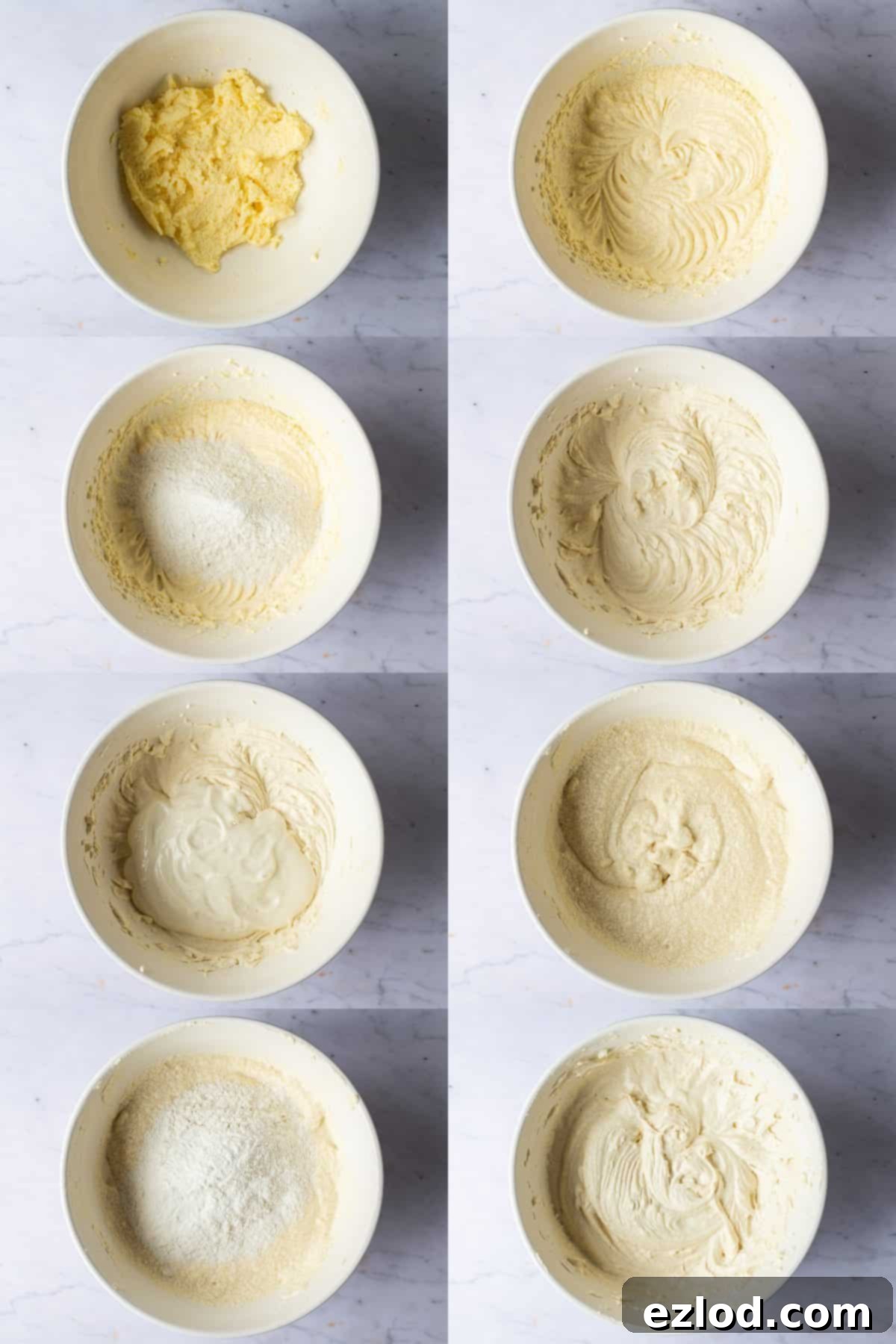
Carefully pour the finished batter into your prepared loaf tin, which should be greased and lined with baking parchment for easy removal. Gently spread the batter evenly across the tin to ensure a flat top surface and uniform baking. Bake the cake in your preheated oven for approximately 50 to 60 minutes. The cake is ready when it turns a beautiful golden brown and a skewer inserted into its centre comes out completely clean, indicating it is thoroughly cooked through. You’ll notice that this pound cake typically bakes with a relatively flat top, rather than a pronounced dome, which is characteristic of its dense structure.
Once baked, remove the tin from the oven and allow the cake to cool in the tin for about ten minutes. This crucial resting period allows the cake to firm up slightly, making it easier to handle without breaking. After ten minutes, carefully invert the tin and turn the cake out onto a wire rack to cool completely. Cooling on a wire rack ensures air circulation around all sides, preventing the bottom of the cake from becoming soggy.
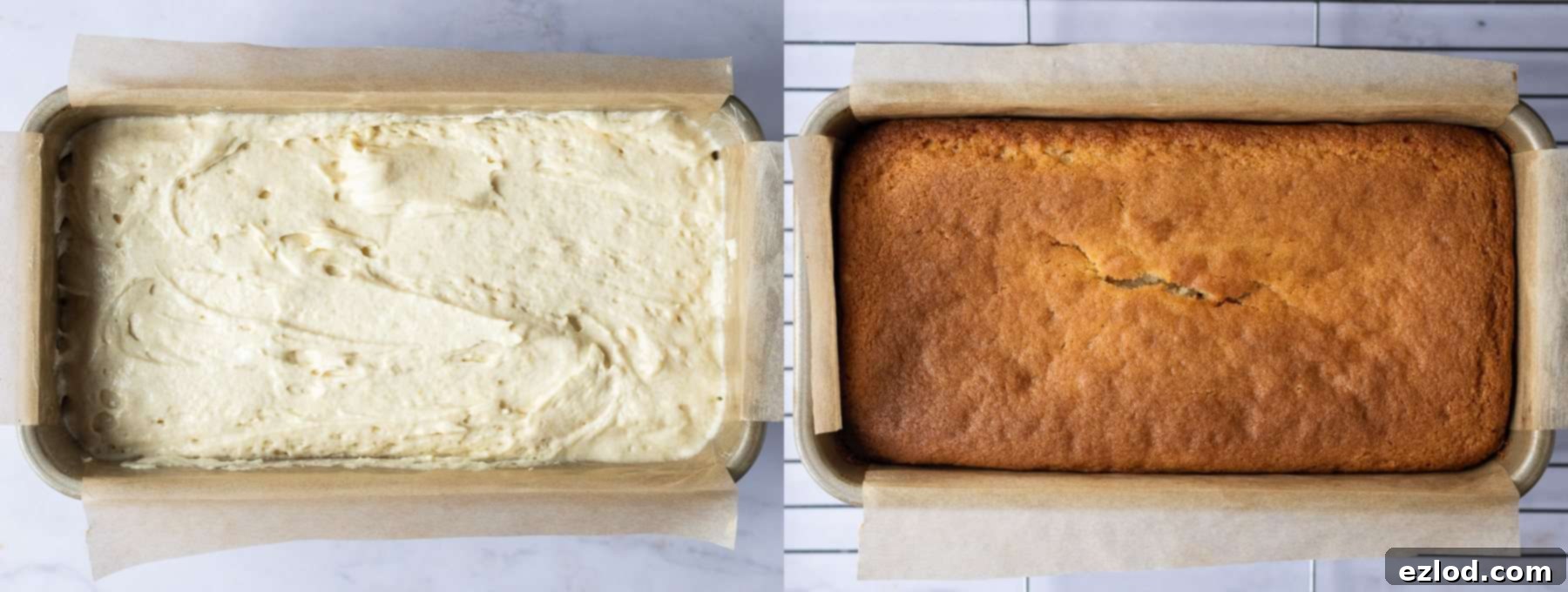
To prepare the simple yet essential lemon glaze, take your sifted icing sugar and gradually stir in fresh lemon juice. Add the juice a little at a time, mixing until you achieve a consistency that is thick enough to cling to the cake but still pourable. The amount of lemon juice may vary slightly depending on the exact humidity and the type of icing sugar, so adjust as needed. Once your cake has cooled completely, artfully drizzle this tangy lemon glaze over the top. The glaze adds an extra layer of lemon flavour and a beautiful, glossy finish.
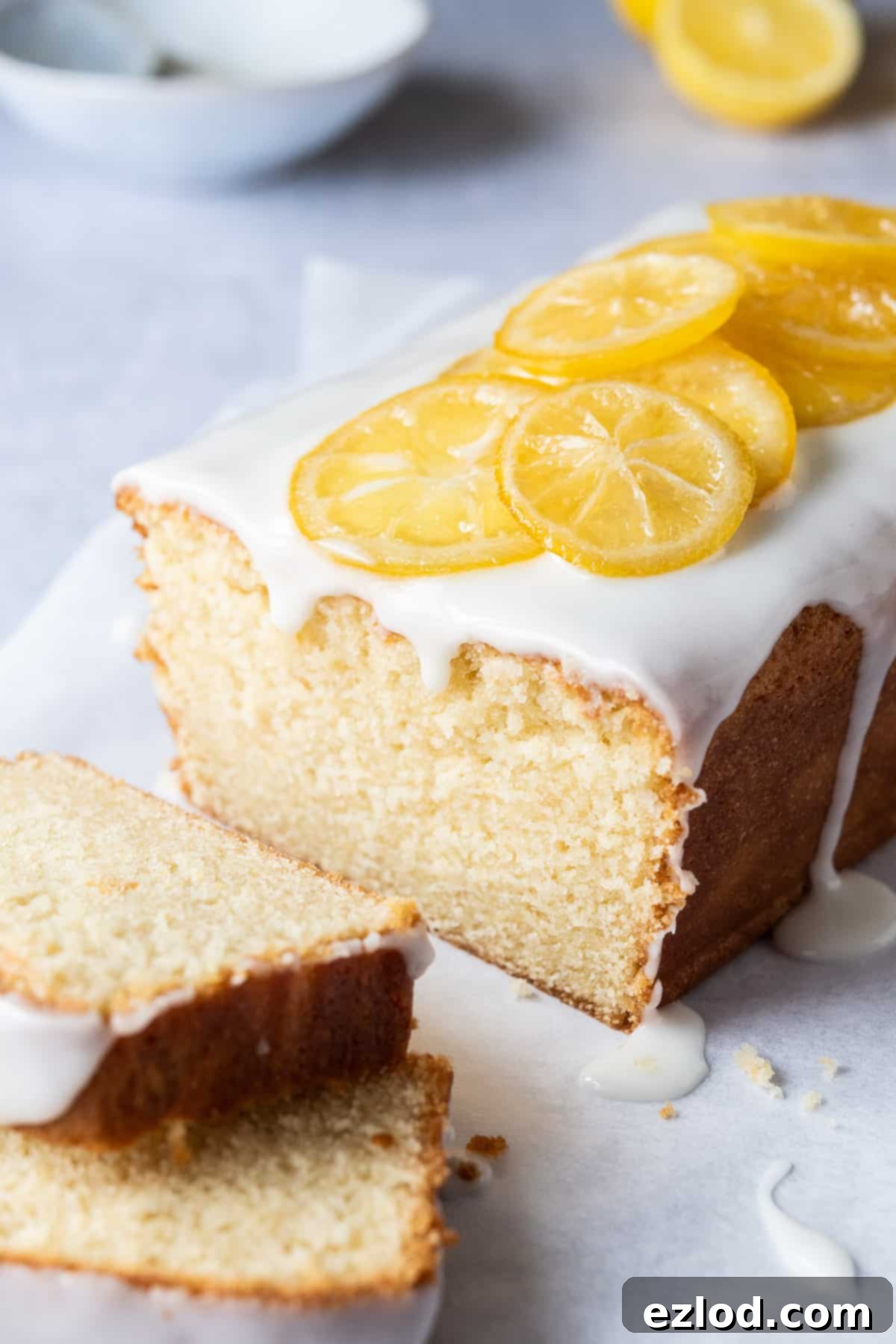
Essential Top Tips for Vegan Pound Cake Perfection
Achieving a truly outstanding vegan lemon pound cake is straightforward with a few key considerations:
1. Precision in Measurement: For the most consistent and best results, it is absolutely vital to follow the recipe closely. As with all baking, I cannot stress enough the importance of weighing your ingredients using gram measurements with a digital kitchen scale, rather than relying on cup conversions. Cup measurements, especially for flour, can vary wildly depending on how tightly packed the ingredient is, making them simply not accurate enough for the precision required in baking. Using grams ensures you get the exact proportions intended, guaranteeing the best possible texture and flavour for your pound cake.
2. Choose the Right Vegan Butter: The type of vegan butter you use significantly impacts the final texture of your cake. For the finest crumb and density characteristic of a pound cake, it is imperative to use a vegan block butter or margarine. These are typically solid, foil-wrapped blocks, specifically designed for baking. Avoid the spreadable kinds that come in tubs, as they contain a much higher water content. This elevated water content can negatively affect the cake’s structure, leading to a less desirable texture that might be too crumbly or not as rich. My personal preference is Naturli Vegan Block, but brands like Stork, Vitalite, or Tormor blocks are also excellent choices (again, ensure they are the solid block versions, not the tub spreads).
3. Understanding Silken Tofu: Silken tofu is the secret ingredient for that perfect pound cake texture in this vegan recipe. It’s important to distinguish that you need firm silken tofu, which is the shelf-stable variety typically found in aseptic packaging, not the refrigerated, water-packed kind. In most UK supermarkets, you can often find it in the ‘Asian’ food section, usually near soy sauce, or sometimes alongside tinned beans. This type of tofu provides the necessary moisture, richness, and binding properties without altering the cake’s flavour profile.
4. Room Temperature Ingredients are Key: For optimal emulsification and a smooth, consistent batter, ensure all your ingredients are at room temperature before you begin mixing. This is particularly important for the vegan block butter and non-dairy milk. Take them out of the fridge at least a couple of hours before you plan to start baking. Room temperature ingredients combine more easily, creating a uniform batter that traps air more effectively, which contributes to a more tender and evenly baked cake.
5. Avoid Over-Mixing the Batter: Once you have added the flour to the wet ingredients, exercise caution and mix only until the batter is just combined and smooth, with no visible streaks of dry flour. Over-beating the batter after the flour is incorporated can lead to overdevelopment of gluten, resulting in a tough, rubbery cake. The goal is a delicate, tender crumb, so mix minimally for the best results.
6. Zest for Success: Always use fresh lemons for their zest. The zest holds the majority of the lemon’s essential oils and offers a far more potent and aromatic flavour than bottled lemon juice alone. For an even more intense citrus punch, you can lightly rub the lemon zest into the sugar before adding it to the butter, releasing more of those fragrant oils.
How To Effortlessly Transform This Into a Vegan Vanilla Pound Cake
Adapting this incredible vegan lemon pound cake recipe into a delightful vanilla pound cake is remarkably simple and requires just a couple of minor adjustments. To achieve a rich vanilla flavour, simply omit the lemon zest entirely from the recipe. In its place, add an extra teaspoon of vanilla extract or, for an even deeper, more complex flavour, use vanilla bean paste.
It’s crucial to remember: DO NOT omit the lemon juice from the cake batter itself. The lemon juice plays a vital role in the chemical reactions within the cake, particularly interacting with the bicarbonate of soda (baking soda) to provide the necessary leavening. This is essential for the cake’s structure and rise, even if you don’t want a lemon flavour. Don’t worry, the small amount of lemon juice used is not enough to make the cake taste strongly of lemon; most of the distinct lemon flavour comes from the zest, which you’ve already omitted.
For the vanilla glaze, you’ll also make a simple swap. Instead of lemon juice, stir approximately 1 ½ to 2 tablespoons of your preferred non-dairy milk (such as soy, oat, or almond milk) into the sifted icing sugar. The exact amount will depend on your desired consistency – aim for a glaze that is thick enough to coat but still pourable. Finish by adding ½ a teaspoon of vanilla extract to the glaze for an extra burst of aromatic vanilla goodness.

Enhance Your Cake: How To Make Beautiful Candied Lemon Slices
While entirely optional, decorating your vegan lemon pound cake with homemade candied lemon slices is a beautiful touch that adds both visual appeal and a lovely textural element. They look sophisticated and are surprisingly straightforward to prepare.
To make them, begin by combining 150g of granulated sugar with 200ml of water in a medium-small saucepan. Place the saucepan over a low heat and stir continuously until all the sugar has completely dissolved, forming a clear syrup. Once the sugar syrup is ready, thinly slice 1 to 2 lemons. Aim for uniform, delicate slices, removing any large seeds. Carefully lay these lemon slices in a single layer within the hot syrup, ensuring they are mostly submerged.
Gently bring the pan up to a steady, low simmer. Allow the lemon slices to cook in the syrup for approximately 30 to 45 minutes. During this time, the lemon rinds will soften significantly, and the slices will gradually become almost translucent. Remember to carefully flip the slices over halfway through the cooking process to ensure they are evenly candied on both sides.
Once cooked, carefully remove the candied lemon slices from the syrup (you can save the leftover lemon syrup for cocktails or drizzling over other desserts!) and arrange them in a single layer on a sheet of baking parchment. Leave them to dry at room temperature for an hour or two. As they cool and dry, they will become slightly firm and less sticky. For the best presentation, it’s ideal not to place the candied lemon slices on the cake until shortly before you plan to serve it, as prolonged contact with the moist cake can make them softer over time.
Explore More Delicious Vegan Loaf Cakes
If you’ve enjoyed baking this vegan lemon pound cake, you’ll be thrilled to discover a world of other delicious plant-based loaf cake recipes. Perfect for snacks, desserts, or a delightful treat with your morning coffee, these loaf cakes offer a variety of flavours and textures to suit every craving. Explore some of our other popular vegan loaf cake creations below:
- Vegan Lemon Drizzle Cake
- Vegan Biscoff Banana Bread
- Vegan Pumpkin Bread
- Vegan Carrot Cake Loaf
- Vegan Courgette Cake (Zucchini Cake)
- Sweet Potato Bread With Pecan Streusel
- Carrot Banana Bread (Vegan)
- Vegan Chocolate Banana Bread
- Vegan Chocolate Chip Banana Bread

If you tried this delightful vegan pound cake recipe, we’d love to see your creations! Don’t forget to tag @domestic_gothess on Instagram and use the hashtag #domesticgothess to share your baking success with our community.
*All images and content on Domestic Gothess are copyright protected. If you wish to share this recipe, please do so by using the provided share buttons. Please do not screenshot, copy, or post the recipe or content in full on other platforms.*

Print
Vegan Lemon (Or Vanilla) Pound Cake
Ingredients
Vegan Lemon Pound Cake:
- 260 g (2 cups + 2 Tbsp) self-raising flour
- ¼ tsp bicarbonate of soda (baking soda)
- ¼ tsp salt
- 120 g (4 ¼ oz) silken tofu
- 120 ml (½ cup) unsweetened non-dairy milk (soy is best) room temperature
- 2 Tbsp lemon juice
- finely grated zest of 2 lemons (optional)
- 1 Tbsp sunflower oil (or another flavourless oil)
- 1 tsp vanilla extract
- 120 g (½ cup) vegan block butter (NOT the spreadable kind. I use Naturli Vegan Block) softened
- 250 g (1 ¼ cups) caster (superfine) sugar
Lemon Glaze:
- 140 g (1 cup + 2 Tbsp) icing (powdered) sugar sifted
- juice of ½ – 1 lemon (or use 1 ½ – 2 Tbsp milk plus ½ tsp vanilla extract)
Instructions
-
Preheat the oven to 180°C/350°F/gas mark 4. Grease an approx 11.5 x 21.5 cm / 4.5 x 8.5 in 2lb loaf tin and line with baking parchment.
-
Sift together the self-raising flour, bicarbonate of soda and salt. Set aside.
-
Place the silken tofu, non-dairy milk, lemon juice, sunflower oil, lemon zest and vanilla extract in a blender and blend until completely smooth. Set aside.
-
In a large bowl, whisk together the softened vegan block butter and caster sugar with an electric mixer until well combined.
-
Add half of the wet ingredients to the butter sugar mixture and whisk until smooth, the mixture will look a bit split but that’s ok.
-
Add half of the dry ingredients and whisk to combine then whisk in the rest of the wet followed by the rest of the dry. Once you have added all of the flour be careful not to over-beat the batter as that can make the cake tough. Just whisk it until it is smooth then stop.
-
Pour the batter into a greased and lined loaf tin and spread it level. Bake the cake for 50-60 minutes until golden and a skewer inserted into the centre comes out clean. The cake will be flat rather than domed on top.
-
Leave it to cool in the tin for ten minutes then carefully turn it out onto a wire rack and leave to cool completely.
-
To make the glaze simply stir enough lemon juice into the sifted icing sugar to create a thick but pourable consistency then drizzle it over the top of the cooled cake.
Notes
- For the best results make sure that you follow the recipe closely. As always, I highly recommend weighing your ingredients using the gram measurements (with a digital scale), rather than the cup conversions. Cup measurements are simply not accurate enough for baking and I cannot guarantee the best results if you use them.
- For the best textured cake it is important to use a vegan block butter/margarine to make this cake – the kind that comes in a foil wrapped block, NOT the spreadable kind in a tub which has too high a water content for baking. I use Naturli Vegan Block but Stork, Vitalite or Tormor blocks are also fine (not the tub versions).
- You need to use firm silken tofu, which is the shelf-stable kind, not the fridge kind. In the UK it can usually be found either in the ‘Asian’ section of the supermarket (by the soy sauce), or next to the tinned beans.
- All of your ingredients should be at room temperature, so make sure to take the butter and milk out of the fridge a couple of hours before baking.
- Make sure that you don’t over-beat the batter once you have added the flour as that can make the cake tough.
How To Make Vegan Vanilla Pound Cake Instead:
Simply omit the lemon zest and add an extra tsp of vanilla extract or vanilla bean paste.
DO NOT omit the lemon juice, the recipe needs that to work.
For the glaze simply swap the lemon juice for the milk of your choice, about 1 ½ – 2 Tbsp; and add ½ a tsp of vanilla extract.
